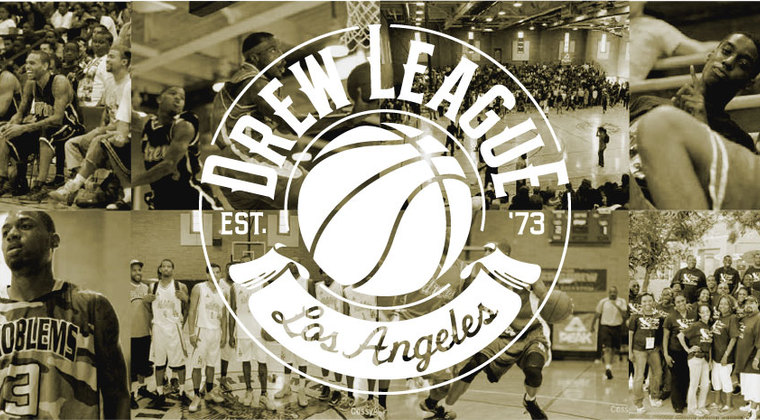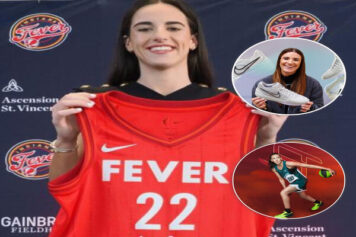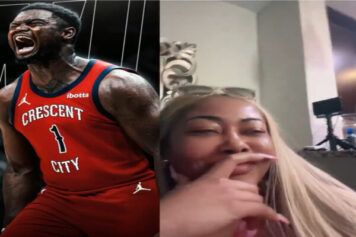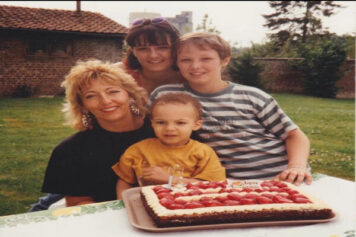Five years ago tonight, we witnessed one of the best sports docs Showtime has ever done. The Drew was a magnificent documentary co-directed and produced by former NBA point guard and South Central Los Angeles native Baron Davis.
It tells the story, with fantastic vintage footage, of the rise of L.A.’s Drew League and walks the reader through its modest, undistinguished beginnings in the rugged, gang-infested South Central streets to its current stature as the world’s best summer pro-am basketball league.
“The film’s vision was always in Baron’s head,” said co-director Chad Gordon. “In 2011, the Los Angeles guys were coming home and playing during the NBA lockout. The best pros started coming, like LeBron. We started out with the film being about the games being played during the lockout, but when we saw how amazing the footage we had was and started talking about the history of the league, everything came into focus.”
Crossing racial, cultural and socioeconomic barriers, The Drew celebrates the value of basketball, persistence, loyalty and above all, community.
Featuring NBA stars like Kevin Durant, DeMar DeRozan, Brandon Jennings and B-Diddy, this is a compelling story that captures the beautiful piece of the tapestry that the venerable Drew League represents in our country’s hoops sub-culture, along with the defining force that it was in the careers of players like former Laker great Byron Scott, Davis and the league’s most accomplished current alumnus, Houston Rockets All-Star James Harden.
I’ve long been fascinated with The Drew League because it merges things that I’m most passionate about: basketball, the power and elevating aspect of sport, mentorship, the importance of family and highlighting the positive stories that exist within our forgotten pockets of urban despair.
It’s much more than a story about a summer basketball league, and more like a love letter to an institution that brings people joy, hope and inspiration.
“The Drew is about the importance of community, and having people at the core of that community to nurture others, illuminating the positive aspects and showing that there are positive things going on, despite the negative perception of South Central and so many other communities like it,” said Gordon.
“These are the types of stories that need to be told, about brotherhood, about the power of family, about this incredible environment, about the positive outlets and role models that do exist. This is a positive story coming from a place that almost never tells positive stories.”
A few years back, I interviewed Drew League commissioner Dino Smiley and a few of the other key people that make up the foundation of this wonderful institution while doing research for a magazine project. I went back into those folders to pull out some compelling information about some ordinary people who are accomplishing some extraordinary things through this prism of love and sport.
***
THE BACKDROP
In the summer of 1973, when Mr. Alvin Willis, an after-school coach at Charles Drew Middle School in South Central Los Angeles, gave birth to a new neighborhood basketball league, a swelling sea of change was sweeping the country.
The Vietnam War was coming to its merciful end. Sprouting from the opportunism that grew out of the political and educational advancements of the civil rights and Black Power movements in the 60s, a force of cultural creativity began coloring the lens through which America was viewed.
There was the music of Curtis Mayfield, Isaac Hayes and James Brown, the bold expressiveness of Black fashion and a groundbreaking cinematic explosion. Jim Kelly was kicking serious hind parts in Bruce Lees classic film Enter The Dragon, while movies like Shaft, Super Fly, Black Caesar and The Mack ushered in an era that laid the foundation for all things currently defined as Cool, Fly, Smooth, Dope, etc.
On the tip of the local hoop, the UCLA Bruins, starring Jamaal Silk Wilkes and Bill Walton and coached by the great John Wooden, won another NCAA championship. Across town, Jerry West and Wilt Chamberlains Lakers got played in the NBA Finals by the Knicks superfluous backcourt of Walt Clyde Frazier, Bill Bradley and Earl The Pearl Monroe.
Dino Smiley, an eighth grade student at Drew Middle School at the time, was in the building from the moment that this new summer league tipped off. During that initial summer, he was stationed atop a ladder, clutching an air horn in front of a blackboard. He kept score with a rag and a piece of chalk.
At the age of 14, Dino was allowed to coach his own team comprised of high school and college players. That next summer, he became the leagues first coach to hustle up a team sponsor Indiana Plumbing Supplies.
In 83, as things started to stagnate, Willis decided to step down and brought the league to an abrupt halt, shutting down a few games into the summer. In 84, Smiley, at the age of 24, decided to re-boot operations. The rest, as they say, is history.
***
THE DIRECTOR
Dino Smiley is a living, breathing, Los Angeles institution. Hes earned the respect and admiration of community members, politicians, gang bangers and the citys finest ballers over his 40-plus years at The Drew League. By day, hes a Parks and Recs Leader for the City, overseeing Washington Park, the leagues current home.
The Drew started to take off and get a name in the late 70s. A few pros would stop in and play, but not consistently. The only other real adult league going on back then was the Joe Weakly Crenshaw League on the west side of town. Around 1988, Joe wanted us to put a team in his tournament.
We took a team over there with guys like Casper Ware, Dwayne Polee and Dane Settles, all legendary names here in L.A. , and won the whole thing.
After that, guys from the west side started migrating over here to the east side. We really started promoting the league, putting schedules and box scores in the local papers and the neighborhood support picked up.
One of the west side coaches put together an all-star team from the Crenshaw League to play in The Drew. He had some big guns Lester Connor, Stevie Thompson, Big John Williams, Larry Spriggs, Tellis Frank and some other great players. They had about a three-year championship run.
That was one of the turning points. That Crenshaw all-star team lit a spark that led to the next phase of growth. Teams from other communities like Pasadena and Riverside started coming in. The overseas market started to open up and more of our players started attracting some of those scouts.
The late, great Raymond Lewis, whos considered the best player to ever come out of Los Angeles, was once a student at Drew Middle School. He would come in here and do his thing. Those were some great shows he put on. When Big John Williams and Lester Connor were here dominating in the early 90s, Ray started coming back. He was in his late 30s and pudgy, but he would get his 45 points on those guys.
During the [Rodney King] riots in 91, everything around us was burned and burglarized. Everybody was on lockdown. When we started up during the first week of May, it was an outlet to everyone. The players just wanted to ball and the community just wanted to watch and get their minds off of everything.
The National Guard was out in the street and there was a curfew, so we didnt play any night games until June. The Drew was one of the first places in South Central to really get back to normalcy. There was an eerie feeling in the air back then.
Baron Davis grew up in here. He played on our youth teams and would hang out to watch the adult league games. He later became one of the reasons The Drew is where it is today.
In the summer of 96, Baron and Kenny Brunner were the top two high school point guard recruits in the entire country. Baron was heading to UCLA and Kenny was leaving for Georgetown. A whole different group came in to watch those games because people really wanted to see those guys go at it. They’d be talking about the matchups on the major radio stations. Things really took off from there.
When they went to college, Paul Pierce started coming in. So did Gilbert Arenas. When Baron made the pros, he started bringing in NBA guys. The next crop of local players started coming through and we got sanctioned by the NCAA in 2001. Guys like Hassan Adams, Trevor Ariza, Marcus Williams, Bobby Brown, Amir Johnson, Javale McGhee, Craig Smith, Gabe Pruitt, James Harden and Nick Young. And theres a good young nucleus of guys coming up that are going to carry the tradition on. – Dino Smiley
***
THE TRADITION
Some of L.A.s finest high school, college and streetball studs, along with some out of town visitors, have competed in the Drew League over the years. Here’s a small sample of some of the notables –
Paul Pierce Baron Davis Kenny Brunner
Klay Thompson Raymond Lewis Byron Scott
Dennis Johnson LeBron James Michael Cooper
Stevie Thompson Big John Williams Trevor Ariza
Gilbert Arenas Mario Bennett Tyron Lue
Nick Young Ricky Davis Andre Miller
Greg Anthony Michael Beasely John Staggers
Jason Hart Dorell Wright Kobe Bryant
Craig Smith Bobby Brown Marcus Williams
Kevin Durant James Harden Mo Spillers
Hassan Adams J.R. Smith Casper Ware Sr.
David Greenwood Lester Connor Metta World Peace
Cuttino Mobley DeMar DeRozan John Wall
Brandon Jennings Stanley Johnson Dane Suttles
JaVale McGee Casper Ware, Jr. Dwayne Polee
***
THE VOICE
There have only been two announcers throughout the league’s history. Mr. Bill Crawford, the original Drew emcee, still comes out for some spot duty and legends games. For the past 20 years, the mic has been handled with aplomb by George Preciado.
I’ve been a fan of the league since I started coming to games at the age of 12. The great Casper Ware was one of those early players that I admired when I was young. I really couldn’t find a job and would always go to the park to talk to Dino. One day, he told me to come and do some games for him. It never crossed my mind to be an announcer and I don’t know where Dino got that from. But he just told me to come through and do it.
I was a nervous wreck at first but, eventually, I calmed down. I enjoy all aspects of the commentary, the play-by-play, throwing in little jabs here and there, just being there to keep the crowd going and adding some flavor to the game.
The gym is always packed, the playoffs are always standing room only and Dinos daughter, Chenelle keeps it hot up in there with the musical selections.
The best nicknames that Ive given are probably The Ghetto Bird, Break Em Off and Gun Smoke. Chris Young was always hovering around the basket. Once that ball comes off the rim, its like he comes down swoopin. I started calling him The Ghetto Bird and that’s what everybody knows him as now.
We started calling Dion Williams Break Em Off because of the way he was breaking off defenders and getting to the rim. And Gun Smoke is a dude in the 40-and-over league. The name speaks for itself.” – George Preciado
***
THE LOW DOWN
The Drew League has been housed at the Washington Park Rec Center for ten years, after calling Drew Middle school home for over thirty. The league sits right in the middle of three notorious neighborhood gangs the Crips, the Bloods and the Florencias.
But no need to worry, there’s a no-fly zone in terms of gang activity around The Drew. Dino and the league have that much juice. There is no gang signage and spray paint – nada, zero, nothing – anywhere in or around the pristine gym.
The gangs have a hands-off policy when it comes to us, everybody knows that, said Smiley. They’ll come in here on the weekends with their families to enjoy the games and we’ve never had a problem. NBA guys drive their Mercedes up here and nobody gets messed with. I’m connected, so if there’s ever a gang issue, I can walk anywhere and try to smooth things out. They respect what we do for the community.
24 teams begin play during the second week of May and the finals are held during the third week in August. Division winners get a bye, then single elimination until a champ is crowned. Normally, two games are held on Friday nights, six on Saturday and four on Sunday. Along with the top notch ball, the food is a major draw as well. The menu consists of homemade fish tacos, fried chicken and fish dinners, hot-sausage links and the mysterious “Drew Aid” beverage.
***
THE TRIVIA
* The Drew was featured in the hit late 70s TV Drama, The White Shadow. In the episode titled The Artist, one of the main characters, Thorpe, realizes that getting a scholarship to UCLA and playing pro ball might not be in the cards for him, especially after seeing all the great talent on the court that never made it to the pros. Dino Smiley can be seen onscreen as one of the game referees.
* Ricky Bell, USCs great running back in the mid 70s ran at The Drew to keep his fitness up during the offseason.
* A half-dozen NBA refs, including Violet Palmer, one of the NBAs few female officials, work Drew games during the summer.
* R&B Singer Brian McKnight was once at the free throw line when some fans started calling his name. When McKnight didnt answer, people in the stands started shouting out names of various R&B singers (Luther Vandross! Freddy Jackson! Barry White!) With each name, the laughter grew more uproarious.




